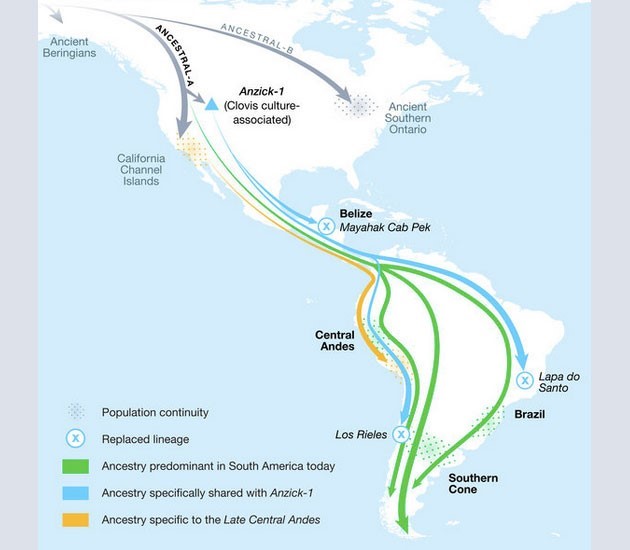Genetics show new pattern of settlement for the Americas
See also: FirstAmerican Immigrants arrived by sea - 16,000+y ago:
An international research team in which participate scientists of the Max-Planck-Institute of Human History, the Harvard Medical School, the University of California-Santa Cruz, Pennsylvania State University, the University of New Mexico and the University of São Paulo is reporting in the scientific journal Cell, that they have investigated the genomes of 49 prehistoric individuals of the Americas aged almost 11,000 years.
The results show that a specific DNA-Type, which is connected with the Clovis-culture, the oldest wide-spread archaeological culture in North America, is to be found 11,000 to 9,000 years ago in Chile, Brazil and Belize as well.
"This means that the people who spread the Clovis-culture exerted also a demographic influence farther south," explains a communiqué of the Max Planck Institute of Human History. „This genetic line, which is connected to the Clovis culture, is missing in the more recent South-Americans. This indicates a replacement of population on the subcontinent which started at least 9,000 years ago.“
“A key discovery has been that one North American individual, ca 12,800y old and connected to the Clovis-culture, shows beyond any doubt a significant parentage with the oldest Chilean, Brazilian and Belizean individuals,” explains Cosimo Posth from the Max-Planck-Institute for Human History, the lead-author of the study. “This reinforces the thesis that the people who spread the Clovis-culture in North America also reached Central and South America."
These individuals from the areas of todays Chili, Brazil and Belize lived more than 9,000 years ago. But individuals who lived after that time, as well as the South-Americans of today, do not share this descendance with the Clovis culture. The co-director fo the study, David Reich, from the Harvard Medical School, adds:
“This is our second important discovery: we have shown that there occurred on the whole subcontinent an replacement of population which occurred beginning at least 9,000 years ago.”.
From this time on, there is a remarkable genetic continuity from the 9,000 years old individuals to the present populations in several South-American regions. In contrast, there exist only few regions in western Eurasia and in Africa displaying such a lengthy genetic continuity.

Copyright: Michelle O’Reilly; Posth, Nakatsuka et al. 2018. Reconstructing the Deep Population History of Central and South America.
Further analyses of the study show that there occurred a second wave of human spreading which was unknown until to now. It shows that the early inhabitants of the Santa Barbara islands in California have a common ancestry with peoples who had spread widely in the South Peruvian Andes some 4,200 years ago.
But this probably doesn’t point to a migration of humans having occurred from the Santa Barbaras to South America. Instead, the team of researchers conjectures that the genetic connection between both regions results from a human migration which occurred thousands of years earlier:
“It is only as a consequence of later events, they think, that this descendance spread farther out into the Andes."
According to Nathan Nakatsuka, of Harvard Medical School, it could'be that
“...This lineage reached South America thousands of years ago, and that we simply do not have any older human remains which can prove this. There is archaeological evidence for the fact that the population of the Central Andes increased drastically about 5,000 years ago. The spreading of certain sub-groups during these events could be a reason why we have been able to distinguish such a descendance later. “
The scientists point out nevertheless, that their study can only convey a small idea of the discoveries which could be achieved by future studies:
“In order to learn more about the early migrations of humans to Central and South America, it would be necessary to obtain DNA from individuals who lived more than 11,000 years ago.“
Beyond this, even the picture for the time span between 11,000 and 3,000 years, which is best covered by this study, is by no means complete:
“We are missing data from Amazonia, from the North of South America and from the Caribbean, so that we were not in measure to examine how the people of those regions are relating to the individuals in our analysis, “ explains Reich. “To close this gap should be a priority of our future research.”


